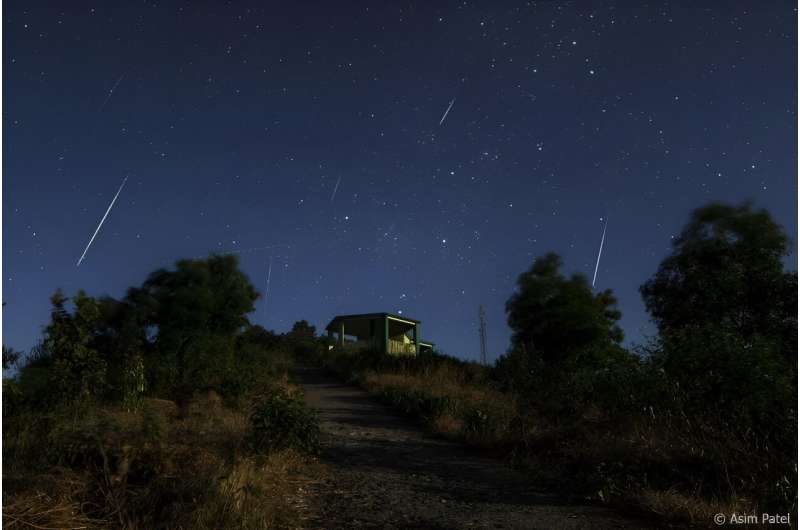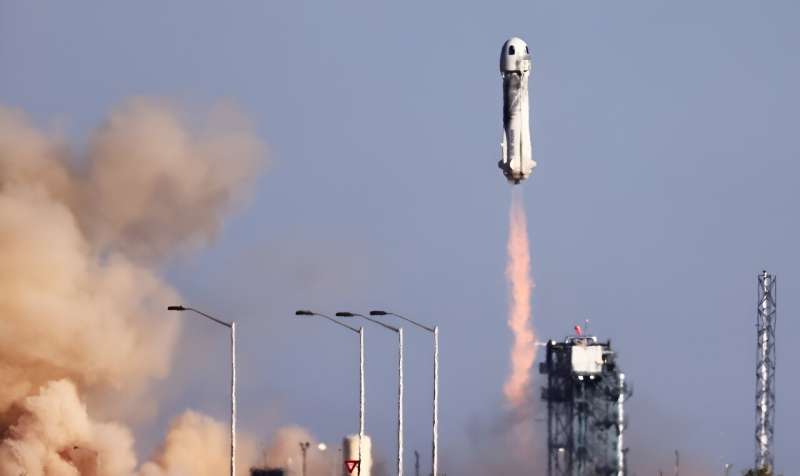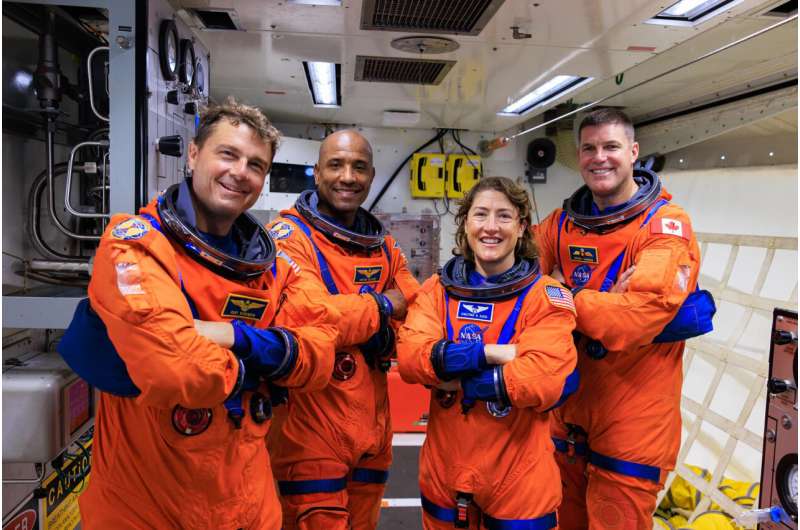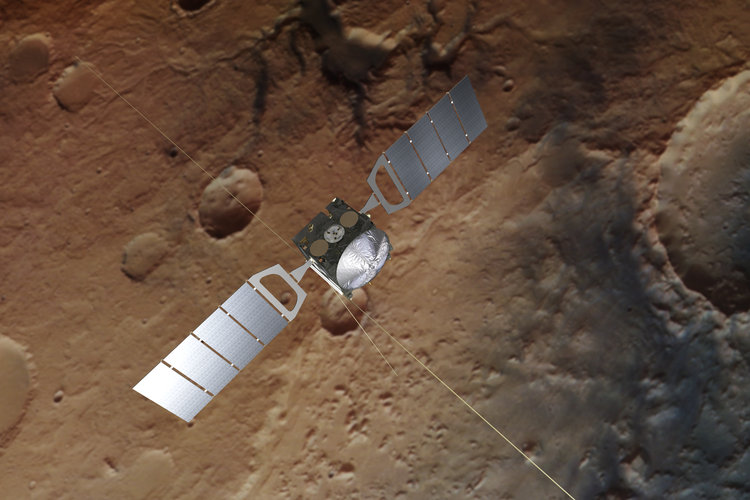
Copernical Team
How and when to see the Geminid meteor shower in the UK

Stargazers will have a chance to enjoy one of the most spectacular meteor showers of the year later this week, as the Geminids reach their peak.
Under perfect conditions, up to 150 meteors an hour could light up the night sky from Thursday into Friday (December 14–15), although the majority of observers can expect to see closer to 40 or 50 an hour as long as skies are clear.
Most meteor showers are caused by comets but the Geminids are unusual because they originate from the debris of an asteroid known as 3200 Phaethon.
They also have a greenish hue when they burn up in the Earth's atmosphere, rather than being colorless or white like other meteors. This is because of their chemical composition—oxygen, magnesium and nickel usually produce a green color.
The good news for skywatchers is that the arrival of a new moon that is just 1% illuminated should make for ideal viewing conditions, because there will less light pollution to weaken what should be a dazzling show.
Blue Origin announces space launch next week, first since 2022 crash

Blue Origin said on Tuesday it was aiming to launch its New Shepard suborbital rocket next week, the first mission since an uncrewed crash in September 2022 set back Jeff Bezos' space company.
"We're targeting a launch window that opens on Dec. 18 for our next New Shepard payload mission," the company tweeted on X, adding the flight would contain 33 science and research payloads, as well as 33,000 postcards.
The Federal Aviation Administration in September announced it had closed its probe into last year's crash, ordering the company to carry out 21 corrective actions before it could resume launches.
Images: Moon, asteroids and new rockets topped the world's space news in 2023

French 'Baguette One' rocket project gets funding
 A French-led consortium said Tuesday it has received funding for its project to develop an innovative low-cost small rocket called "Baguette One" and launch it into space.
HyPrSpace along with a joint venture of Italian defence firm Leonardo and French IT firm Thales, and CT Engineering are pursuing the 35-million-euro ($38-million) project that aims to demonstrate a new type of rocket engin
A French-led consortium said Tuesday it has received funding for its project to develop an innovative low-cost small rocket called "Baguette One" and launch it into space.
HyPrSpace along with a joint venture of Italian defence firm Leonardo and French IT firm Thales, and CT Engineering are pursuing the 35-million-euro ($38-million) project that aims to demonstrate a new type of rocket engin Permafrost thaw: a silent menace
 Video:
00:05:47
Video:
00:05:47
Ice is without doubt one of the first casualties of climate change, but the effects of our warming world are not only limited to ice melting on Earth’s surface. Ground that has been frozen for thousands of years, called permafrost, is thawing – adding to the climate crisis and causing serious issues for local communities.
Scientists estimate that the world’s permafrost holds almost double the amount of carbon that is currently in the atmosphere. When permafrost warms and thaws, it releases methane and carbon dioxide, adding these greenhouse gases to the atmosphere and making global warming even worse.
ESA explores bold new approach to Mars orbit

ESA is venturing towards putting a spacecraft into orbit around Mars using a technique that engineers have studied for over half a century but never dared to attempt.
Galactic winds discovered in ancient star-forming galaxies
 In a groundbreaking discovery, an international research team, led by a CNRS scientist, has unveiled the role of galactic winds in regulating the growth of galaxies, including those over 7 billion years old that are actively forming stars. This revelation, made possible through the use of the MUSE instrument integrated into the European Southern Observatory's Very Large Telescope, sheds light on
In a groundbreaking discovery, an international research team, led by a CNRS scientist, has unveiled the role of galactic winds in regulating the growth of galaxies, including those over 7 billion years old that are actively forming stars. This revelation, made possible through the use of the MUSE instrument integrated into the European Southern Observatory's Very Large Telescope, sheds light on HyperScout H Readies for ESA's Hera Mission
 HyperScout H, developed by cosine, has a rich history in Earth observation, but its origins lie in planetary science. Now, it's returning to its roots as an integral part of the European Space Agency's (ESA) Hera mission. The HyperScout H hyperspectral imager has reached a series of significant milestones, signifying its readiness for the mission.
The HyperScout H imager has successfully c
HyperScout H, developed by cosine, has a rich history in Earth observation, but its origins lie in planetary science. Now, it's returning to its roots as an integral part of the European Space Agency's (ESA) Hera mission. The HyperScout H hyperspectral imager has reached a series of significant milestones, signifying its readiness for the mission.
The HyperScout H imager has successfully c US, UK, Australia Collaborate on Deep Space Radar Initiative for Enhanced Space Domain Awareness
 The United States, United Kingdom, and Australia have jointly unveiled a significant trilateral initiative known as the Deep Space Advanced Radar Capability (DARC). This collaboration aims to bolster space domain awareness by providing 24/7, all-weather capabilities to detect, track, identify, and characterize objects in deep space. The memorandum of understanding (MOU) underpinning this project
The United States, United Kingdom, and Australia have jointly unveiled a significant trilateral initiative known as the Deep Space Advanced Radar Capability (DARC). This collaboration aims to bolster space domain awareness by providing 24/7, all-weather capabilities to detect, track, identify, and characterize objects in deep space. The memorandum of understanding (MOU) underpinning this project Long March rockets mark their 500th spaceflight
 China's Long March rocket family has achieved a milestone with its 500th spaceflight, using a Long March 2D carrier rocket to deploy several remote-sensing satellites. This event, which took place on Sunday morning from the Xichang Satellite Launch Center in Sichuan province, underscores China's growing prowess in space technology.
The launch, conducted at 9:58 am, was visually striking, w
China's Long March rocket family has achieved a milestone with its 500th spaceflight, using a Long March 2D carrier rocket to deploy several remote-sensing satellites. This event, which took place on Sunday morning from the Xichang Satellite Launch Center in Sichuan province, underscores China's growing prowess in space technology.
The launch, conducted at 9:58 am, was visually striking, w 
